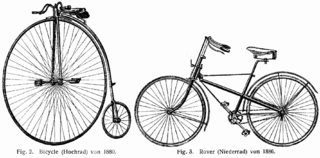
In business theory, disruptive innovation is innovation that creates a new market and value network or enters at the bottom of an existing market and eventually displaces established market-leading firms, products, and alliances. The term, "disruptive innovation" was popularized by the American academic Clayton Christensen and his collaborators beginning in 1995, but the concept had been previously described in Richard N. Foster's book Innovation: The Attacker's Advantage and in the paper "Strategic responses to technological threats", as well as by Joseph Schumpeter in the book Capitalism, Socialism and Democracy.
The ISO 9000 family is a set of international standards for quality management systems. It was developed in March 1987 by International Organization for Standardization. The goal of it is to help organizations ensure that they meet customer and other stakeholder needs within the statutory and regulatory requirements related to a product or service. The ISO refers to the set of standards as a "family", bringing together the standard for quality management systems and a set of "supporting standards", and their presentation as a family facilitates their integrated application within an organisation. ISO 9000 deals with the fundamentals and vocabulary of QMS, including the seven quality management principles that underlie the family of standards. ISO 9001 deals with the requirements that organizations wishing to meet the standard must fulfill. A companion document, ISO/TS 9002, provides guidelines for the application of ISO 9001. ISO 9004 gives guidance on achieving sustained organizational success.
New product development (NPD) or product development in business and engineering covers the complete process of launching a new product to the market. Product development also includes the renewal of an existing product and introducing a product into a new market. A central aspect of NPD is product design. New product development is the realization of a market opportunity by making a product available for purchase. The products developed by an commercial organisation provide the means to generate income.

Risk assessment determines possible mishaps, their likelihood and consequences, and the tolerances for such events. The results of this process may be expressed in a quantitative or qualitative fashion. Risk assessment is an inherent part of a broader risk management strategy to help reduce any potential risk-related consequences.
In business administration, absorptive capacity is defined as a firm's ability to recognize the value of new information, assimilate it, and apply it to commercial ends. It is studied on individual, group, firm, and national levels. Antecedents are prior-based knowledge and communication. Studies involve a firm's innovation performance, aspiration level, and organizational learning. It has been said that in order to be innovative an organization should develop its absorptive capacity.

Life cycle assessment (LCA), also known as life cycle analysis, is a methodology for assessing environmental impacts associated with all the stages of the life cycle of a commercial product, process, or service. For instance, in the case of a manufactured product, environmental impacts are assessed from raw material extraction and processing (cradle), through the product's manufacture, distribution and use, to the recycling or final disposal of the materials composing it (grave).
In the context of software engineering, software quality refers to two related but distinct notions:

A business analyst (BA) is a person who processes, interprets and documents business processes, products, services and software through analysis of data. The role of a business analyst is to ensure business efficiency increases through their knowledge of both IT and business function.
A technology roadmap is a flexible planning schedule to support strategic and long-range planning, by matching short-term and long-term goals with specific technology solutions. It is a plan that applies to a new product or process and may include using technology forecasting or technology scouting to identify suitable emerging technologies. It is a known technique to help manage the fuzzy front-end of innovation. It is also expected that roadmapping techniques may help companies to survive in turbulent environments and help them to plan in a more holistic way to include non-financial goals and drive towards a more sustainable development. Here roadmaps can be combined with other corporate foresight methods to facilitate systemic change.
Open innovation is a term used to promote an Information Age mindset toward innovation that runs counter to the secrecy and silo mentality of traditional corporate research labs. The benefits and driving forces behind increased openness have been noted and discussed as far back as the 1960s, especially as it pertains to interfirm cooperation in R&D. Use of the term 'open innovation' in reference to the increasing embrace of external cooperation in a complex world has been promoted in particular by Henry Chesbrough, adjunct professor and faculty director of the Center for Open Innovation of the Haas School of Business at the University of California, and Maire Tecnimont Chair of Open Innovation at Luiss.
Technology forecasting attempts to predict the future characteristics of useful technological machines, procedures or techniques. Researchers create technology forecasts based on past experience and current technological developments. Like other forecasts, technology forecasting can be helpful for both public and private organizations to make smart decisions. By analyzing future opportunities and threats, the forecaster can improve decisions in order to achieve maximum benefits. Today, most countries are experiencing huge social and economic changes, which heavily rely on technology development. By analyzing these changes, government and economic institutions could make plans for future developments. However, not all of historical data can be used for technology forecasting, forecasters also need to adopt advanced technology and quantitative modeling from experts’ researches and conclusions.

Life-cycle engineering (LCE) is a sustainability-oriented engineering methodology that takes into account the comprehensive technical, environmental, and economic impacts of decisions within the product life cycle. Alternatively, it can be defined as "sustainability-oriented product development activities within the scope of one to several product life cycles." LCE requires analysis to quantify sustainability, setting appropriate targets for environmental impact. The application of complementary methodologies and technologies enables engineers to apply LCE to fulfill environmental objectives.
Design science research (DSR) is a research paradigm focusing on the development and validation of prescriptive knowledge in information science. Herbert Simon distinguished the natural sciences, concerned with explaining how things are, from design sciences which are concerned with how things ought to be, that is, with devising artifacts to attain goals. Design science research methodology (DSRM) refers to the research methodologies associated with this paradigm. It spans the methodologies of several research disciplines, for example information technology, which offers specific guidelines for evaluation and iteration within research projects.
Technology Intelligence (TI) is an activity that enables companies to identify the technological opportunities and threats that could affect the future growth and survival of their business. It aims to capture and disseminate the technological information needed for strategic planning and decision making. As technology life cycles shorten and business become more globalized having effective TI capabilities is becoming increasingly important.
Technology scouting is an element of technology management in which
Innovation Intermediaries is a concept in innovation studies to help understand the role of firms, agencies and individuals that facilitate innovation by providing the bridging, brokering, knowledge transfer necessary to bring together the range of different organisations and knowledge needed to create successful innovation. The term open innovation intermediaries was used for this concept by Henry Chesbrough in his 2006 book as "companies that help other companies implement various facets of open innovation".
Corporate foresight has been conceptualised by strategic foresight practitioners and academics working and/or studying corporations as a set of practices, a set of capabilities and an ability of a firm. It enables firms to detect discontinuous change early, interpret its consequences for the firm, and inform future courses of action to ensure the long-term survival and success of the company.
Industrial artificial intelligence, or industrial AI, usually refers to the application of artificial intelligence to industry and business. Unlike general artificial intelligence which is a frontier research discipline to build computerized systems that perform tasks requiring human intelligence, industrial AI is more concerned with the application of such technologies to address industrial pain-points for customer value creation, productivity improvement, cost reduction, site optimization, predictive analysis and insight discovery.
In business administration, desorptive capacity has been defined as "an organization’s ability to identify technology transfer opportunities based on a firm’s outward technology transfer strategy and to facilitate the technology’s application at the recipient". It is considered as a complement to absorptive capacity, and it may be a driver of a successful knowledge transfer.
Value-based engineering (VBE) is a system development and innovation approach that implements the IEEE St. 7000 "Model Process for Addressing Ethical Concerns during System Design" released in 2021. The standard was developed over a five-year period based on the initial work published in "Ethical IT innovation: A value-based system design approach" in 2015. Similar to value sensitive design, the standard's intent is to provide a framework for the consideration of human values and ethical concerns. In Fall 2022, it was adopted by the International Organization for Standardization as ISO/IEC/IEEE 24748-7000.




